August 17 I am trying to get into the wood splitting and wood sawing groove working for as much of the morning as the mosquitoes will allow, and they are slowly diminishing. However, I still take my walks on the road casting my eyes about and I began focusing in on a small shrub with white berries, a white baneberry bush.

I have my baneberries covered this year, having already seen the red baneberry plant. At the end of my walk, where the road skirts White Swamp, I saw that the delicate, charming arrowhead flower that I saw in South Bay is also in this swamp.

Leslie and I have been struggling with the identification, but now that I found them here, I should be getting a better look at them. The water seems much higher than usual in White Swamp, perhaps because there are more beavers and the dam that creates the swamp, which we’ve never seen as it is a couple miles away, might be in better repair. While searching for black raspberries Leslie saw an argiope spider in her web.

There was also a much smaller spider nearby and we wondered if that was the male. I was unable to get a photo of it.
August 18 On my morning walk I saw another arrowhead flower and this time I could see the leaves associated with the plant. The loosestrife surrounding that flower doesn’t have arrow shaped leaves.

Otherwise, that’s a nice bunch of vegetation there. The mosquitoes have kept me from sitting next to the Deep Pond after dinner, and so I haven’t see the beaver there since the 10th. I keep looking at the dam repair the beaver did near the chair where I sit. For example on the 11th, it looked like this:

And like this on the 16th:
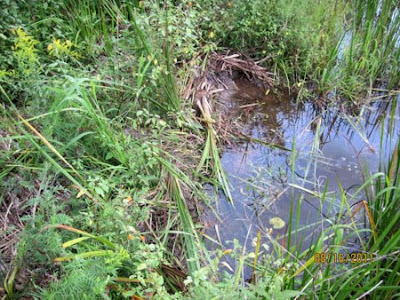
I kept thinking I was seeing evidence of new visits, but it slowly dawned on me that all I was seeing was the pond getting lower which kept those repairs damp and looking different as if the beaver had been back. So late this afternoon I walked around the pond to look for some unmistakable signs that the beaver was still living in the pond. I went via the Third Pond on the chance that the beaver moved back up there now that it is once again filled with water, but I didn’t see any fresh beaver work there. I took a photo of the dam so I could better tell if the beaver came back and pushed mud, grass, or logs up on it. I went down the trail that passes our most productive apple tree and was sorry to see its leaves were all yellow and some apples already dropping. Crossing through the lush meadow and then looking out at the vegetation on the surface of the pond, I thought a beaver would be foolish to leave. So I tried to make the case that is was still there. The high bank of the pond is riddled with burrows and I think at least four could accommodate a beaver. I saw a gap in the vegetation between the bank and the deep part of the pond.

Deer could not wade out that far. But if the beaver was there, it might break a trail through the vegetation to the bank. I walked around the pond so I could look back at the bank and saw a trail through the vegetation to a burrow.

But the grasses on shore where the burrow is didn’t look plodded upon. Stepping back some more I could see that it didn’t look like anything had been foraging in the corner of the pond where I had seen the beaver foraging before.

That said, I did see what looked like a bit of fresh mud under the bonesets right along the shore.
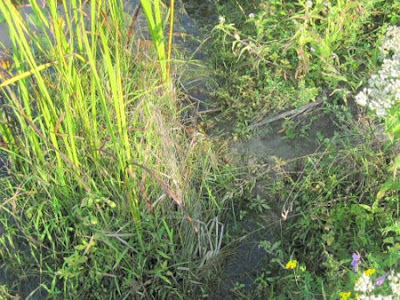
However, as the water level drops the shore can look muddy and usually the beaver has flattened a larger area when it got up on shore to groom. The water lily blooms had closed up for the night but I could see that some were still there. As I crossed over the tiny inlet creek, flooded but not running, I couldn’t resist taking a photo of the crowd of Joe Pye weed trying to stretch up and get a look at the pond.
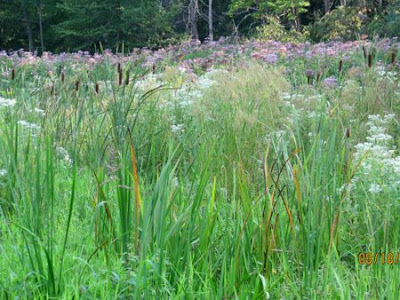
The boneset was crowding closer to the pond, blocking my way to the lodge.

Nice companions and they make up for the relative lack of vervain here this year. I could fancy that I saw a trail through the vegetation going from the lodge over to the deep part of the pond which I had just inspected.

And the bottom of part of the pond there was muddy brown suggesting that a beaver might have eaten the plants off the bottom. Standing next to the pond, I was pleased to find another arrowhead plant not only with the delicate white flowers but a clear view of the delicate arrowhead leaves.

Not far from that, and up on the shore, not in the water, I saw another delicate flower, much smaller and pink.

Purple-leaved willow-herb, I think. The lodge did not look unused,

But not much different from the last photo I took of the lodge way back on August 2, after which I know the beaver went in and out there for another week.

So I hoped that as I stood there, the beaver would come swimming out of the lodge, but it didn’t. Plus the beaver, as far as I can tell, never pushed through the vegetation to check out any trees on the edge of the woods. Indeed as I did so, I found quite a few maple saplings back in the area where I usually monitor spring flowers. I climbed up on the knoll, amazed that the trail I cut in the spring was still useable, no flowers up there now, but I saw lichens everywhere, which I had never noticed there before.
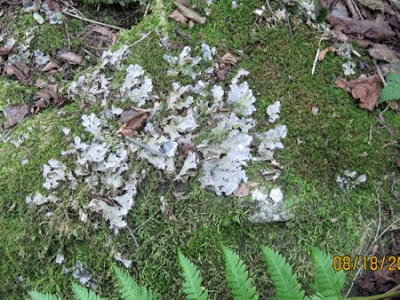
I kept glancing down at the pond hoping the beaver was out, but it wasn’t. Just off the knoll I saw that some grapes were ripening. I completed my inspection by taking photos of the dam. I looked at the first area the beaver had patched from the east, the opposite direction from my other photos of it.

From this angle the mud looks fresher even factoring in that the water level is dropping. The next area the beaver had mudded over looks like it has been worked on too

The last photo I have is from the 11th and certainly it looks like the beaver had visited since then.

The third area the beaver patched also show evidence of more work, even a much broader attack on the area,

judging from how the area looked on the 11th.

Ergo, the beaver is still here? Immediately behind the dam there were two more pieces of evidence. Suggesting that a beaver had been hard at work was the sight of the brown bottom of the pond suggesting that the beaver rooted up all the plants there -- not something accomplished quickly and I didn’t notice it last time I was out on the dam.

However, the same photo shows only one plant pulled up, and an active beaver often leaves more leftovers behind. I also saw what I suppose is a broader leafed arrowhead plant.

I’ve seen this before here, can’t remember the flower nor how the fruit develops. Meanwhile the mushrooms continue to flourish and one amanita right next to our house

Is proving to be an avid collector of natural things.
August 19 I worked all morning splitting, sawing and straightening my piles. Before dinner I turned my attention back to the beaver in the Deep Pond. I had evidence that it was there and evidence that it had left -- I have not seen it for over a week and the evidence that it's still in the pond is not conclusive. I thought a reinspection of what I saw yesterday might reassure me that it was still there. I checked the Third Pond dam first and I thought I saw something new, a small nibbled sticks laid perpendicular to the dam. But when I compared a photo I took today with the one I took yesterday, I can see that the water level dropped a little and the shadows were different. The little nibbled stick was there yesterday too. I took the shady trail down to the Deep Pond, through the woods passing by stumps of dead ironwoods I cut this year and last. I was pleased to see mushrooms thriving in that nexus of death in an otherwise healthy woods.

Some mushrooms seemed to be bursting at their seams, so to speak.

As I approached the Deep Pond I saw ripples in the deep part of the pond, but the duck in the pond flew up from the shadows in front of the lodge. Then as I began to walk along the high slope of the pond, a beaver slapped its tail over along the south shore and dove. I crouched in the shade of a small honeysuckle bush on the slope down to the pond and waited. When the beaver was up at the Third Pond, it was often out at about 5:30 pm. Perhaps my usually seeing it come out later at the Deep Pond, after 7 pm, was only because I didn’t wait and watch between 5 and 6. I expected the beaver to surface well away from me, if it surfaced at all. Instead it surfaced right in front of me.

My immediate impression was that it was a different beaver. It looked smaller, redder, and more high strung than the beaver I was used to seeing. Although its tail looked cocked for another slap, it didn’t splash again. It swam with the weaving pattern of an alarmed beaver.

Now and then doing some serious sniffing of the air.

Well, I wasn’t doing much good alarming the beaver. I wanted it to feel comfortable in the pond. So I walked away as meekly as I could as if obeying its commands -- though I don’t think beavers can see that well. Since then I’ve been debating whether it is a new beaver. From looking at the videos from the last two months and the video I took today,
I formed the impression that this beavers ears were bigger in relation to its head. So here is a photo of the old beaver.

The shape of the ears look the same. Here is a photo of the old beaver swimming and the cock of the ears look about the same.

I still think the photos show the old beaver looking larger than the new one, but that could arise from the angle I had looking down on the beaver today. Well, I will probably get a good look at the beaver again, and, if I am lucky, I will see two beavers in the pond. Of the several beavers who I’ve seen in this pond, only one made scent mounds and seemed to defend territory it claim by unsuccessfully trying to ward off another beaver (or were they in love -- I could never quite decide though they didn’t stay together for more than a season.) The beavers who come here most likely come up from White Swamp which is roughly about two square miles of wetland with enough open water to allow beavers a stress free life, save for the human trappers. I’ve long thought of the Deep Pond as a refuge for beavers from White Swamp whose settled lives get warped by the trappers. Indeed, most of the beavers who’ve come here seemed to me to be managing various kinds of stress. One didn’t seem to go into a burrow or lodge for months. Others were small and obviously inexperienced judging by how they nosed up to me. Some seemed timid and disinclined to eat, which is very un-beaver-like. Indeed the beaver that came to the Third Pond and Deep Pond this year seemed to be the first normal beaver to come up here. The last beavers here seemed to make a couple and I had hopes that they might have kits but then a bobcat stalked the pond, and I soon had the confusion of one dead beaver, the remaining beaver leaving and then in a few weeks two beavers returning, spending the winter together and then leaving in the spring. I’ve been watching beavers for 17 years and one would think I would be better able to sort them out. Knowledge, science, requires some degree of abstraction and when confronted with a beaver I turn to putty, even more infatuated than I once was with pretty girls for with them I always had an immediate sense of my chances. But with a beaver, it’s pure love, a pure show-me-your-world-and-I-will-worship-it. And with a beaver, I lose all feeling of aggression, of dominance, of superiority. I don’t sit and predict what they will do next. I lose any sense of emulation, which is very much what fuels my otter watching. And to successfully track otters you have to carry an edge to the pond or the river, you have to be on your toes, you have to predict. I am not bragging about this. I shouldn’t put beavers on a pedestal or worshipfully confine them to a relatively perfect world. They too have miles to go before they sleep.
August 22 On my morning walk, I stopped at the Deep Pond dam to see if the beaver or beavers worked on the dam. As usual, it looked like new vegetation and mud had been pushed up on the dam.

But a closer look at old photos shows that the dam there is really about the same as it was several days ago. I went down toward the knoll to check the grapes I saw there; still not perfectly ripe, and the blushing honeysuckles berries show them up.

The nearby nannyberry has fruit that looks like perfect grapes, but evidently nothing eats nannyberries.

To my surprise, the water lilies in the pond are still blooming perfect flowers and the lily pads looked unmolested by insects or age.

I know there is at least one beaver here but I am beginning to think that my hunch that there might be two was just a result of my infatuation at seeing the old beaver in a new light. I helped Leslie with her garden work and then, since she was busy, picked black raspberries around the Teepee Pond. I think about 3 or 4 years ago I found the berries on the southeast side of the pond halfway up the slight sandstone ridge. There were no berries along the path where they had been. The berries had progressed down the ridge closer to the pond. I could visualize the berry laden stickers dropping closer to the pond each Fall. A couple years ago, or maybe three, I had the great notion of clearing out much of the honeysuckle and buckthorn so I could get a view of the pond as I sat on the ridge. Many honeysuckles have grown back forming a wall now just behind where the berries are flourishing, all behind a dense jungle of a meadow with here are there a dead tree, a legacy from the beavers who left in the fall of 2005.

However, where the dense honeysuckles curl over the first step of the rock ridge there are caves of green protecting the mosses and ferns thriving in the damp under the overhang.

Tangled up as they were with honeysuckles in many places, the berries were not that easy to pick.

Plus a good many of them were not ripe yet. Three bushes had died from the drought and others had many more red berries than blueblack. I got enough to supplement dessert for four. Leslie had been here a week or so before and I thought I could see her trail. Closer to the pond, I saw the fawn’s trail.

A healthy meadow must seem like a second womb to a fawn. I could see one turtle on a log on the north shore of the pond and also a thick, healthy stand of pickeral weed.
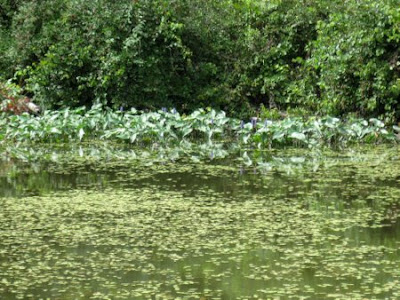
Too bad the honeysuckles are so thick over there that I can’t get a close look at them. However there were some beauties in the thin crop along the south shore.

This is the best year that I can remember for pickeral weed.

I took photos of the mushrooms along the path between the pond and the road. There were less varieties, and the small orange mushrooms seemed to dominate.

The beige mushrooms that form colonies are beginning to hit their stride.

Around our house a large mushroom had no patience for colonizing around a piece of the dead wood. As the mushroom erupts from the humus, its dome is uplifting the much larger limp wood chip.

The fuzzy focus makes it look like an action-photo. Just before dinner I had a chance to check on the Deep Pond beaver or beavers. I went down via the Third Pond and gazing at the pond got the impression that not much had changed, and if there were now two beavers in the pond, there would probably be evidence of more ado, maybe even a scent mound. However, I could see that vegetation was being cleared toward the middle of the pond.

I walked around toward the lodge which in this context might be the best place to mud up a scent mound marking a claim. On my way I got another photo of the arrowhead plant showing how the thin leaves were now overshadowing the fading flowers.


There was no scent mound near the lodge and no evidence that a beaver had come up on shore near the lodge where I had seen the beaver groom itself a few weeks ago. If two compatible beavers were in the pond this grooming spot might get larger as the beavers groomed each other. There was more to look at floating in the water outside the lodge, a few dead sticks and nipped grasses.

But there didn’t appear to be any changes to the lodge.

And as I stood there, no beavers torpedoed out from the lodge, surely what would happen if two beavers were there. As I walked back around the pond, I saw a bird nest in a low shrub under the boneset plants.

Nice place to be hatched and raised. Then as I walked along the high bank, I looked back and saw a beaver swimming out from the lodge toward me. I sat down and waited to get a better look at it. It dove but I was able to trace its path under the water by the bubbles coming to the surface and when it surfaced it was not lit up by the sunlight and looked much like the beaver I’ve been seeing for months.

It also acted as of old, no tail slaps, and after a brief sniff at me, it dove again. I had trouble following it but in a minute or so I saw it swimming toward the dam which it seemed to inspect without once climbing up on the dam or pushing anything up on it.
Another interpretation of its behavior was that it swam furtively over to the chair where I usually sit to see if there was another human sitting there and I trust was relieved to find that its impression from the other sun drenched afternoon that there were two humans was wrong after all. As best as I could tell, it then went into the mass of lily pads and pondweeds and had a bite.
August 24 Leslie saw a milk snake in the garden. I got several photos of it as it was not disposed to move from the warm bare dirt.

I took a tour of the valley that the beavers left back in May. The last time I was here the leak at the Boundary Pond dam had either slowed or stopped altogether and water had once again collected in the pools and channels all the way up to the upper part of the Last Pool. We’ve probably had a half inch to an inch of rain since I was last here, not enough to get water flowing into and through the whole valley, but enough to keep the water up in the last pool, but still not enough to flood back to the beavers’ last lodge.

I suspect this may be the new low depth of water for this area, save during droughts, which is not bad. The channel down the middle of the Last Pool continues to attract frogs big and small. I should get on my knees and make a study of that. The mosquitoes should quit before the frogs do, making it a pleasant afternoon’s work. Where there is still shade the vegetation is recovering slowly, which is good.

Looking down the channel toward the part of the valley now more exposed to the sun, I worry that grasses might dominate where there used to a forest of ferns.

The mucky flats between the mossy mounds that stayed above water even when the pond was at its fullest look largely unvegetated. I don’t know why I think ferns will be the last plants to recover, but I expect them to dominate these flats.

If I saw the upper end of Boundary Pond without knowing what has happened here in the last year, I would say that it appears to be a healthy little pond and that a beaver might have just parted and eaten some of the duckweed. But I know better. However I am not sure why all the water is not covered with duck weed.

That certainly is the case down behind the dam,

And around the lodge where once again there is a sheet of water from the far shores to the lodge interrupted only by old piles of sticks the beavers left.

After walking around the pond, I went up on the ridge west of it, and looking down from there saw the channels free of duckweed.

But absolutely no fresh signs of beavers. Perhaps some muskrats have moved back to the lodge. Meanwhile as I walked around the pond over the ground that had been flooded over or ice covered for about a year (I should check to see exactly how long that was,) I tried to get a sense of what types of vegetation is growing now. Rather far from the water, I saw one of those grasses with the spikey seeds, burreeds, that often grow just at the edge of the water.

Then I saw low flowering plants that I assume are bur-marigold. On the island this plant is the first to take over the flats left behind when ponds drain away. On the one hand the yellow flowers are quite pretty in the late summer, then the seeds cling to you all during the fall.
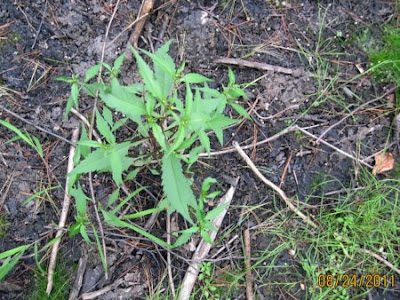
I saw some patches of vigorous pilewort plants. They have the flower that never blooms but breaks down all fuzzy. The pilewort is usually much larger than the bur-marigolds but never takes over an area.

Not that these flats are hosting competing patches of vegetation. In most places there is a mixture grass, small plants and low bedstraw type vines beginning to entangle everything else.

This all looks promising, but there is also a battle between water and earth as puddles and pools seem to grow out from the pond proper. Of course, grass can grow up in such shallow water.

There are once again some puddles in the mud flats to the side of the pond which look like they are waiting for the pond to expand again.

Along the east shore, the old east shore, of the pond, the trunk of an old maple, I assume, tumbled over. The beavers had nothing to do with it. The tree had died well before we bought the land and the upper part of the tree tumbled over. I used to sit on the remains of that sometimes as I waited for the beavers to swim up Boundary Pond.

I wonder what finally topples over a rotting trunk like this. Maybe the rain soaked upper part of the trunk got too heavy for the rotting stump. Speaking of stumps, there is a low one that must have been at least half covered with water which now has a nice garden on it, including a possible maple sapling, though probably not.

Judging by how the water clear of duckweed expanded along the dam, perhaps the clear water is where the pond expanded due to the recent rain and the duckweed has not had time enough to spread.

Then I walked along the back of the dam with my camcorder running to hoping to get video of frogs jumping into the duckweed. Alas there were few frogs there, unlike along the deep channels of the pond. When frogs did jump into the pond they left a trail in the duckweed.
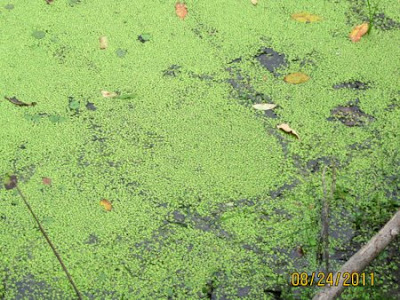
I took my usual portrait of the lodge which I must say does look striking surrounded by duckweed. When the beavers were here the duckweed did spread in this section of the pond, but the beavers then seemed to eat quite a bit.

Then I went up the ridge and into what we call the Hemlock Cathedral where it remains rather dark year round since the hemlocks always have needles. In the summer when the oaks, maples and basswoods have leaves it is even darker. There was a pretty good array of mushrooms, most of them healthy as far as I could tell, which for me, means bursting at the seams,

Or flopping over from their great weight.

As I moved into the darker parts of the woods, the mushrooms were smaller but perhaps more persistent in their peaking up out of the ground -- or peeking, like little bloodshot eyes.

Unfortunately the camera muffed the shots in the dark which was too bad because many small mushrooms showed the variety of their perfections. But I did stumble on nice illustrative photos that should make it easier to identify the mushrooms.

And another shot which nicely accentuates the obvious: mushrooms show a sense of companionship.

But the intriguing pair below seemed to have had a fight and one mushroom got all the spots.

I was surprised to see the bogs under the hemlocks swelling,

Some day I should figure that out but I have been saying that for 13 years now.
August 26 I am beginning my campaign to get firewood like a gentleman and no longer act like a beaver. I took a sawhorse with me so that I would no longer have to get low on the ground and wrestle with the wood. I hoped that a sawhorse would inspire me to take advantage of the ease of sawing by cutting trunks up into shorter lengths that I could carry out with less effort. No longer would I, like a beaver, start hauling some large section of a tree only to find it too heavy or too easily ensnared by other trees and bushes. Meanwhile I kept my eye on Boundary Pond hoping that some muskrats were still using it, but I didn’t see any. I continue to marvel at how well the beavers cleared this area of scrubby vegetation. If a few of the large trees had not died from flooding, we would have a park like area here, though be careful of stumbling on the innumerable stumps the beavers left behind. In the old days I recall sitting on an anvil shaped rock on the east side of the valley in the shade of the many hemlocks.

I took my first break from sawing over there and took a photo looking across the valley,

Hoping that in those old days I took a similar photo of what I recall being a fairly impenetrable thicket. I haven’t found one yet. There was a smattering of small yellow mushrooms on the shady ridge behind the anvil rock.

And as I carried logs from my sawhorse back to my sawing rock near the house, I had to avoid a nice variety of mushrooms: several like coral castles,

an elegant watchtower,

and an invading army
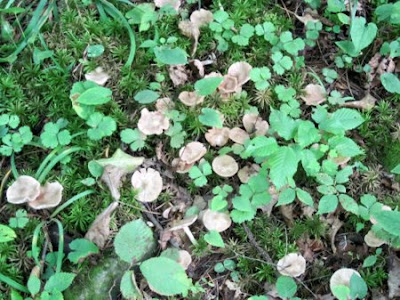
On my way back to the valley in the afternoon, I went via Ripple Rock Trail so that I walked through the meadow above the Last Pool. I wanted to make sure there were no bur-marigold or pilewort plants up there. As usual at this time of year I walked through many goldenrods, some white aster and I spotted my first purple asters of the year.

I do an injustice to the golden rod by showing the purple flowers lording over it because golden rods rule the meadow. (My annual take photos of all types of goldenrod trek is still 3 or 4 weeks away.) Golden rods stopped where the beavers had flooded the valley. I was pleased to see that the water from the dam had backed up farther in the Last Pool, now almost reaching the lodge and half filling the channel through the old cache pile and up to the wallow.

To be sure another foot or two of water is needed to make this viable for muskrats and a little more needed for beavers. But meanwhile the revealed muck is sporting all sorts of plants. To begin with, I should take back my earlier insistence that ferns flourish in the shade. I saw a healthy clump of them on one of the mossy mounds bathed in the sunshine.

I hastened to find the shine-shy ferns that I expect to do well in this muck.

Despite it being relatively late in the growing season, I see new plants that seem to be just getting their start. No telling if they will grow enough in the next month for me to identify them.

I also found some nice patches of smartweed here, and I should make a careful identification since I think this plant might have grown just as well if the pond still had water in it.

Then I got down to the channel and found that the frogs here that are so skittish in the morning are a bit more mellow in the afternoon, and I was able to get several photos. The first frog seems about as large as they get here.

And I thought its size made it relatively brave and not swim under water. Then I saw two frogs half that size linger as I hovered over them.

And then I began seeing rather small frogs at their ease.

You can judge the size of the frog by its size relative to the duckweed which is more or less a constant size. Not all frogs congregate along the banks of the pond and channel, I saw some in the mud flats several leaps away from the water.

It seemed perfectly camouflaged as an emerging plant. Since mushrooms thrive on ambient death, I expected this forest litter of the old pond bottom to host some and today I finally saw one.

Those mossy mounds that were flooded are now becoming gardens, mostly ferns.

Then I got down to Boundary Pond, bottom now exposed, and I wanted to supplement the photos I took two days ago. I saw some fan grass surrounded by gossamer grasses.

I also saw the vigorous fronds of blue flag iris, though not the seeds. Then I saw a plant that looked like a wild mint. The leaves were aromatic when crumbled but not exactly a whiff of mint. So I better see how it develops before I identify it.

There were several smaller yellow blossoms about, yellow wood-sorrel.

I also made a point of checking the pileworts and bur-marigolds and I saw that there were two different plants that I am identifying as bur-marigold. There is a bigger plant that grows straight up and a smaller plant with mostly purple stems. I found one of the former in bloom and the smaller plant ranging vine-like on several tree trunks, though it also grows straight out of the ground too.

Confusing. Soon they’ll all be blooming and I should be able to properly identify everything, ha ha.
August 27 The mosquitoes seem to be winding down, or they are becoming more bearable. I can once again sit beside the ponds and enjoy myself. First I sat by the Third Pond. On the way, I heard a kingfisher cackle and I briefly saw goldfinches eating the seeds of the elecampane. Then when I found my seat next to the pond, I tried to video the flights and feedings of two vireos, and think I saw one eat a honeysuckle berry

but they flew off. I think there was a small flock of them. Then I sat down and watched some cedar waxwings perched high on a willow tree.

When they flew out over the middle of the pond and hovered I could see the beautiful yellow in their tail feathers. But that took place so quickly I only got a few seconds of video of that.
I never saw the kingfisher. Only the cedar waxwings remained as I walked away back to the road. I sat in the chair beside the Deep Pond dam and swatting away mosquitoes soon felt comfortable enough to wait for the beaver. Soon enough it appeared in the deep section of the pond. It turned and swam toward me. It didn’t come too close, but I suppose it was still inspecting me.

Then it turned back and swam toward its lodge under the knoll but stopped frequently to eat some of the plants floating on the pond.

Then it continued on toward the lodge. I saw what looked like a large plant that had been pulled up and was now floating in front of the lodge.

I hoped the beaver would eat a bit of that. But the beaver disappeared under water and swam into the lodge.
It seemed to me that it came out simply for a quick bite. I don’t think my presence bothers it any more.
No comments:
Post a Comment